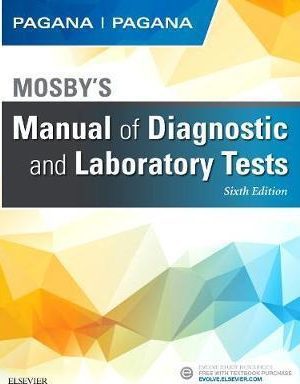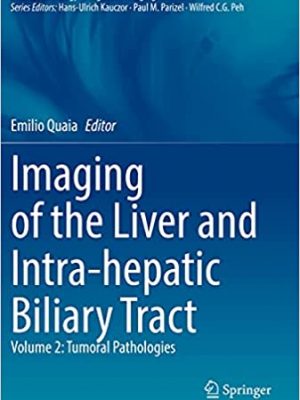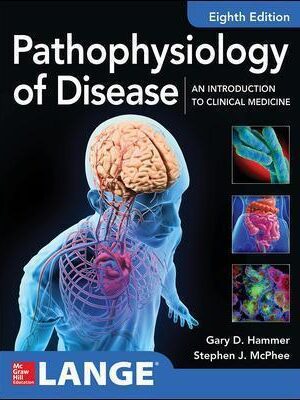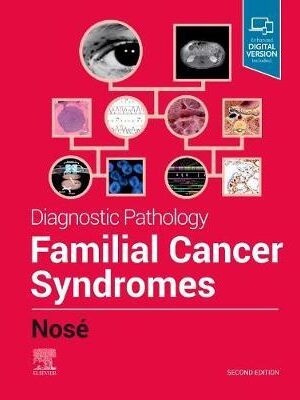Diagnostic Pathology: Familial Cancer Syndromes 2nd Edition
Diagnostic Pathology: Familial Cancer Syndromes Second Edition:
This expert volume in the Diagnostic Pathology series is an excellent point-of-care resource for practitioners at all levels of experience and training. Physicians should have the knowledge derived from morphological findings to identify the likelihood of a cancer patient having an additional underlying familial syndrome― and to decide if that patient should undergo molecular genetic evaluation. This volume is specifically designed to help pathologists, oncologists, and other physicians who diagnose and treat cancer to recognize syndromes and syndrome- associated neoplasms and advise patients and their families on the possibility of a familial syndrome and their risk of developing other tumors. Diagnostic Pathology: Familial Cancer Syndromes, second edition, is an easy-to-use, one-stop reference for information on hereditary cancer syndromes, including differential diagnosis and management, that offers a templated, highly formatted design; concise, bulleted text; and superior color images throughout.
- Contains all the information necessary to determine whether a neoplasm typically encountered in daily practice is sporadic or related to a familial cancer syndrome
- Features a revised structure to keep you up to date: Part I includes more than 80 detailed chapters describing diagnoses associated with familial cancer syndromes; Part II contains more than 70 chapters with detailed descriptions of major syndromes (cross-referenced with diagnoses); and Part III features a molecular factors index that includes a complete description of each known gene associated with a familial cancer syndrome
- Contains updated chapters with newly classified GI, neurology, multiple organ, eye, endocrine, GYN, and kidney tumors, as well as more than 20 entirely new chapters covering recently recognized syndromes
- Incorporates up-to-date molecular findings and their significance for familial cancer syndromes; new techniques and technologies being used to discover gene mutations and other alterations; and details on personalized medicine targeted to specific genes
- Features more than 2,200 images throughout, including clinical and radiological images, algorithms, graphics, gross pathology, histology, and a wide range of special and immunohistochemical stains―all carefully annotated to highlight the most diagnostically significant factors
- Features time-saving bulleted text, key facts in each chapter, an extensive index, and numerous tables for quick reference and thorough understanding
- Includes the enhanced eBook version, which allows you to search all text, figures, and references on a variety of devices
Additional ISBNs:
∗ eText ISBN: 978-0323712064, 9780323712064
- See additional information on the Amazon.
More Details
Diagnostic Pathology: Familial Cancer Syndromes 2nd Edition:
Front Cover
Title page
Table of Contents
Copyright
Dedication
Contributing Authors
Preface
Acknowledgments
Sections
Part I: Diagnoses Associated With Syndromes by Organ
SECTION 1: BLOOD AND BONE MARROW
Chapter 1: Acute Lymphoblastic Leukemia and Non-Hodgkin Lymphoma
Chapter 2: Blood and Bone Marrow Table
SECTION 2: BONE AND SOFT TISSUE
Chapter 3: Chondrosarcoma
Chapter 4: Chordoma
Chapter 5: Malignant Peripheral Nerve Sheath Tumor
Chapter 6: Osteosarcoma
Chapter 7: Rhabdomyosarcoma
Chapter 8: Schwannoma
Chapter 9: Bone and Soft Tissue Table
SECTION 3: BREAST
Chapter 10: Breast Carcinoma
Chapter 11: Breast Table
SECTION 4: ENDOCRINE
ADRENAL CORTEX
Chapter 12: Adrenal Cortical Adenoma
Chapter 13: Adrenal Cortical Carcinoma
Chapter 14: Adrenal Cortical Neoplasms in Children
Chapter 15: Primary Pigmented Nodular Adrenocortical Disease
Chapter 16: Adrenal Cortex Table
ADRENAL MEDULLA AND PARAGANGLIA
Chapter 17: Adrenal Medullary Hyperplasia
Chapter 18: Neuroblastic Tumors of Adrenal Gland
Chapter 19: Pheochromocytoma and Paraganglioma
Chapter 20: Adrenal Medulla and Paraganglia Table
PANCREAS
Chapter 21: Pancreatic Neuroendocrine Neoplasms
Chapter 22: Endocrine Pancreas Table
PARATHYROID
Chapter 23: Parathyroid Adenoma
Chapter 24: Parathyroid Carcinoma
Chapter 25: Primary Parathyroid Hyperplasia
Chapter 26: Parathyroid Table
PITUITARY
Chapter 27: Pituitary Adenoma
Chapter 28: Pituitary Hyperplasia
Chapter 29: Pituitary Table
THYROID, MEDULLARY
Chapter 30: C-Cell Hyperplasia
Chapter 31: Medullary Thyroid Carcinoma
Chapter 32: Thyroid, Medullary Carcinoma Table
THYROID, NONMEDULLARY
Chapter 33: Familial Thyroid Carcinoma
Chapter 34: Follicular Thyroid Carcinoma
Chapter 35: Thyroid, Nonmedullary Carcinoma Table
SECTION 5: GASTROINTESTINAL
HEPATOBILIARY AND PANCREAS
Chapter 36: Hepatoblastoma
Chapter 37: Hepatocellular Carcinoma
Chapter 38: Pancreatic Adenocarcinoma
Chapter 39: Biliary Tract/Liver/Pancreas Table
TUBULAR GUT
Chapter 40: Colonic Adenomas
Chapter 41: Esophageal Adenocarcinoma
Chapter 42: Esophageal Squamous Cell Carcinoma
Chapter 43: Gastric Adenocarcinoma
Chapter 44: Gastrointestinal Stromal Tumor
Chapter 45: Hamartomatous Polyposis Syndromes
Chapter 46: Small Bowel Adenocarcinoma
Chapter 47: Colon/Rectum Table
Chapter 48: Esophagus/Stomach/Small Bowel Table
SECTION 6: GENITOURINARY
BLADDER
Chapter 49: Bladder Urothelial Carcinoma
Chapter 50: Bladder Table
KIDNEY
Chapter 51: Angiomyolipoma
Chapter 52: Clear Cell Renal Cell Carcinoma
Chapter 53: Cystic Nephroma
Chapter 54: HLRCC Syndrome-Associated Renal Cell Carcinoma
Chapter 55: Papillary Renal Cell Carcinoma
Chapter 56: Renal Oncocytoma, Chromophobe, and Hybrid Tumors
Chapter 57: Succinate Dehydrogenase-Deficient Renal Cell Carcinoma
Chapter 58: Wilms Tumor
Chapter 59: Kidney Table
PROSTATE
Chapter 60: Prostate Carcinoma
Chapter 61: Prostate Table
RENAL PELVIS AND URETER
Chapter 62: Renal Urothelial Carcinoma
Chapter 63: Ureter Urothelial Carcinoma
Chapter 64: Renal Pelvis and Ureter Table
TESTICLE
Chapter 65: Germ Cell Tumor
Chapter 66: Sertoli Cell Neoplasms
Chapter 67: Testicle Table
SECTION 7: GYNECOLOGY
Chapter 68: Cervical Carcinoma
Chapter 69: Fallopian Tube Carcinoma
Chapter 70: Ovarian Tumors
Chapter 71: Endometrial Carcinoma
Chapter 72: Gynecologic Tumors
SECTION 8: HEAD AND NECK
Chapter 73: Endolymphatic Sac Tumor
Chapter 74: Head and Neck Squamous Cell Carcinoma
Chapter 75: Head and Neck Table
Chapter 76: Salivary Glands Table
SECTION 9: NERVOUS SYSTEM
Chapter 77: Central Nervous System
Chapter 78: Eye
Chapter 79: Peripheral Nervous System
SECTION 10: PULMONARY
Chapter 80: Adenocarcinoma, Lung
Chapter 81: Adenocarcinoma With Lepidic (Bronchioloalveolar) Predominant Pattern
Chapter 82: Lymphangioleiomyomatosis
Chapter 83: Neuroendocrine Tumor, Lung
Chapter 84: Pleuropulmonary Blastoma
Chapter 85: Lung Table
SECTION 11: SKIN
Chapter 86: BAP1-Inactivated Melanocytic Tumor
Chapter 87: Basal Cell Carcinoma
Chapter 88: Cutaneous Melanoma
Chapter 89: Cutaneous Squamous Cell Carcinoma
Chapter 90: Sebaceous Carcinoma
Chapter 91: Skin Table
Part II: Overview of Syndromes
SECTION 1: INTRODUCTION
Chapter 92: Pathology of Familial Tumor Syndromes
Chapter 93: Clinical Diagnosis and Management of Familial/Hereditary Tumor Syndromes
Chapter 94: Molecular Aspects of Familial/Hereditary Tumor Syndromes
SECTION 2: SYNDROMES
Chapter 95: Ataxia Telangiectasia
Chapter 96: BAP1 Tumor Predisposition Syndrome
Chapter 97: Basal Cell Nevus Syndrome/Gorlin Syndrome
Chapter 98: Beckwith-Wiedemann Syndrome
Chapter 99: Birt-Hogg-Dubé Syndrome
Chapter 100: Bloom Syndrome
Chapter 101: Brooke-Spiegler Syndrome
Chapter 102: Carney Complex
Chapter 103: Colonic Carcinoma Syndromes
Chapter 104: Costello Syndrome
Chapter 105: Denys-Drash Syndrome
Chapter 106: Diamond-Blackfan Anemia
Chapter 107: DICER1 Syndrome
Chapter 108: Down Syndrome
Chapter 109: Dyskeratosis Congenita
Chapter 110: Familial Acute Myeloid Leukemia and Myelodysplastic Syndrome
Chapter 111: Familial Adenomatous Polyposis
Chapter 112: Familial Chordoma
Chapter 113: Familial Gastrointestinal Stromal Tumor
Chapter 114: Familial Infantile Myofibromatosis
Chapter 115: Familial Isolated Hyperparathyroidism
Chapter 116: Familial Nonmedullary Thyroid Carcinoma
Chapter 117: Familial Paraganglioma Pheochromocytoma Syndrome
Chapter 118: Familial Testicular Tumor
Chapter 119: Familial Uveal Melanoma
Chapter 120: Familial Wilms Tumor
Chapter 121: Fanconi Anemia
Chapter 122: Glucagon Cell Hyperplasia and Neoplasia
Chapter 123: Breast/Ovarian Cancer Syndrome: BRCA1
Chapter 124: Breast/Ovarian Cancer Syndrome: BRCA2
Chapter 125: Hereditary Diffuse Gastric Cancer
Chapter 126: Hereditary Leiomyomatosis and Renal Cell Carcinoma Syndrome
Chapter 127: Hereditary Mixed Polyposis Syndrome
Chapter 128: Multiple Osteochondromas
Chapter 129: Hereditary Neuroblastoma
Chapter 130: Hereditary Pancreatic Cancer Syndrome
Chapter 131: Hereditary Papillary Renal Cell Carcinoma
Chapter 132: Hereditary Paraganglioma/Pheochromocytoma Syndromes
Chapter 133: Hereditary Prostate Cancer
Chapter 134: Hereditary Renal Epithelial Tumors, Others
Chapter 135: Hereditary Retinoblastoma
Chapter 136: Hereditary SWI/SNF Complex Deficiency Syndromes
Chapter 137: Howel-Evans Syndrome/Keratosis Palmares and Plantares With Esophageal Cancer
Chapter 138: Hyperparathyroidism-Jaw Tumor Syndrome
Chapter 139: Juvenile Polyposis Syndrome
Chapter 140: Li-Fraumeni Syndrome
Chapter 141: Lynch Syndrome
Chapter 142: McCune-Albright Syndrome
Chapter 143: Melanoma/Pancreatic Carcinoma Syndrome
Chapter 144: Multiple Endocrine Neoplasia Type 1 (MEN1)
Chapter 145: Multiple Endocrine Neoplasia Type 2 (MEN2)
Chapter 146: Multiple Endocrine Neoplasia Type 4 (MEN4)
Chapter 147: MUTYH-Associated Polyposis
Chapter 148: Neurofibromatosis Type 1
Chapter 149: Neurofibromatosis Type 2
Chapter 150: Nijmegen Breakage Syndrome
Chapter 151: Pancreatic Neuroendocrine Tumor Syndromes
Chapter 152: Hamartomatous Polyps, Peutz-Jeghers
Chapter 153: PTEN-Hamartoma Tumor Syndromes
Chapter 154: RASopathies: Noonan Syndrome
Chapter 155: Rhabdoid Predisposition Syndrome
Chapter 156: Schwannomatosis
Chapter 157: Shwachman-Diamond Syndrome
Chapter 158: Steatocystoma Multiplex
Chapter 159: Tuberous Sclerosis Complex
Chapter 160: Tumor Syndromes Predisposing to Osteosarcoma
Chapter 161: von Hippel-Lindau Syndrome
Chapter 162: Werner Syndrome/Progeria
Chapter 163: Wilms Tumor-Associated Syndromes
Chapter 164: Wiskott-Aldrich Syndrome
Chapter 165: Xeroderma Pigmentosum
Part III: Reference
SECTION 1: MOLECULAR FACTORS
Chapter 166: Molecular Factors Index
INDEX



























 Dentistry
Dentistry
Reviews
There are no reviews yet.